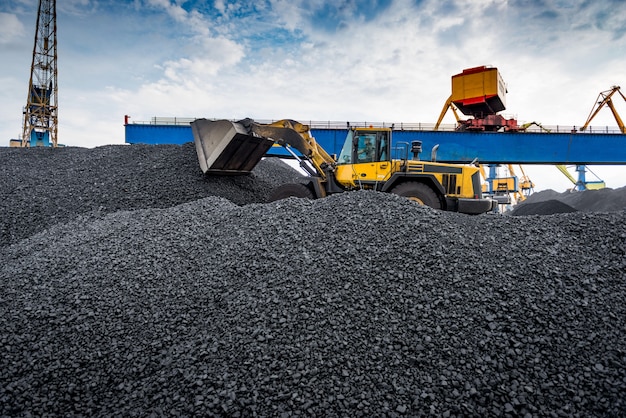Coal Mining – Overview

Before jumping into a coal mining pit, have a brief history to know. Do you know coal was burned in funeral pyres in Wales? Yes, during the Bronze Age, between 3,000 and 4,000 years ago, according to archaeological evidence the rituals were held. In Meteorologica, Aristotle mentions coal (“combustible materials”), and his pupil Theophrastus remembers its use as well. In 1228, the first coal came in London by sea, from Fife and Northumberland, where women and children retrieved lumps broken from underwater outcroppings and brought ashore by wave action. Following that, the term “sea coal” was used to refer to all bituminous coal in England. Many Asian countries also have huge deposits of coals. Okay! Enough of coal’s history. Let’s get into the present time and read about today’s coal mining.
Formation of Coal: Coalification
Coal is a sedimentary rock that contains a mixture of components, the majority of which are of plant origin. Carbon, hydrogen, oxygen, nitrogen, sulfur, and a few inorganic mineral elements make up the majority of plant matter. The carbon content of this material increases as it decays underwater in the absence of oxygen. Peat is the first by-product of this decomposition process. Peat can be found in bogs, marshes, and freshwater swamps, and enormous freshwater swamps in the past provided ideal circumstances for the production of thick peat deposits that eventually turned into coal reserves. The pressure exerted by sedimentary materials accumulating on peat layers causes peat to change into lignite. The change of lignite to bituminous and anthracite coal is caused by increased pressures and heat caused by movements of the Earth’s crust (as occurs during mountain formation) and, on rare occasions, igneous intrusion.
Different Types of Coal Mining Method
Surface mining and underground mining are the two types of mining methods used to extract coal seams. Surface and underground coal mining are vast activities with many different types of equipment and processes, and the method used to extract a coal seam is determined by a variety of technological, economic, and social considerations. Here are the two methods, widely used:
1. Surface Coal Mining
Surface coal mining means first clearing the land and remove the top layers of the soil. Then, drill the hard strata above the coal steam and blast it with explosives. Expose the coal steam and clean the top of the coal seam. This is what surface mining means in nutshell.
Methods of Surface Mining:
- Area strip Coal Mining – When the terrain is flat, Area mining begins with a trench or “box cut” through the overburden to expose a section of the coal seam. In the strike direction, this trench is extended to the property’s bounds. Following the removal of the coal, a second cut is made parallel to the first, with the overburdened material from this cut being deposited in the void of the first. The operation is repeated in parallel cuttings until the stripping ratio indicates that surface mining is unprofitable.
- Contour strip Coal Mining – Where a coal seam outcrops in undulating or hilly terrain, contour mining is typically used. Essentially, the procedure entails removing the overburden above the coal seam and then constructing a bench around the hill, beginning at the outcrop and progressing up the hillside. Previously, the blasted overburden spoil was simply tossed down the hill; now, the soil is hauled down the mountain in horizontal strata to fill a specified valley, or it is replenished on the working bench itself in spots where coal has been taken. Further cuttings into the hillside will be done if the break-even stripping ratio remains favorable. Otherwise, if significant reserves exist beneath the hill’s knob, the coal may be retrieved through underground mining or augering.
- Open-pit Coal Mining – Several benches are established in both the overburden strata and the coal seam during open-pit coal seam mining. When dense coal seams are overlain by thick or thin overburden, the open-pit method is used; it is also used to mine steeply pitching coal seams. Significant volumes of overburdened materials must be accumulated in vast dump areas during the early stages of mining.
- Auger Coal Mining – Contour strip mining is often associated with auger mining. The coal is removed using this procedure by drilling auger holes from the last contour cut and retrieving it in the same way as a carpenter’s bit produces shavings. With this process, coal recovery rates exceed 60%. Some augers have cutting heads that reach a height of 2.5 meters. Additional auger stems are added as each stem progresses further into the coal seam, resulting in hole depths of more than 60 to 100 meters. Augering is linked to issues like subsidence, water contamination, and probable fires.
2. Underground Coal Mining
The geologic medium, which consists of the coal seam and the overlying and underlying layers, totally encloses the working environment in underground coal mining. Access to the coal seam is acquired through adequate apertures on the surface, and a network of highways driven into the seam permits the installation of service facilities for human and material transportation, ventilation, water treatment and drainage, and power. Mine development is the phrase for this stage of an underground mining operation. During mine development, the extraction of coal from the seam is sometimes referred to as “first mining,” while the exploitation of the remaining seam is referred to as “second mining.”
Methods of Underground Mining:
- Longwall Coal Mining – Coal mine development in the longwall mining method is done in such a way that big blocks of coal, typically 100 to 300 meters broad and 1,000 to 3,000 meters long, are available for complete extraction. The height of coal taken, the width of the longwall face, and the thickness of the slice (varying from 0.6m to 1.2 m) determine the size of a block of coal.
- Room-and-pillar Coal Mining – A number of parallel entries are driven into the coal seam using this method. At regular intervals, wider entries, referred to as rooms, are cut through the seam at right angles to the entries. The ensuing grid arrangement provides thick coal pillars that support the earth and rock strata above. The conventional and continuous room-and-pillar systems are the two most common. Separate equipment and labor crews perform the unit activities of undercutting, drilling, blasting, and loading in the traditional system. One machine, the continuous miner, removes coal from the face and feeds it directly into a hauling unit in a continuous operation. After loading, the uncovered roof is supported by rock bolts in both techniques.
- Shortwall Coal Mining – The layout of the Shortwall mining method is similar to that of the longwall method, with the exception that the coal block is not more than 100 meters broad. In addition, the slices are up to three meters thick and are cut by a continuous miner. A face conveyor or other face haulage equipment is used to dump the mined coal. The ceiling is supported by specifically built shields that function similarly to longwall shields. Shortwall mining was expected to have a bright future, but it has not lived up to predictions.
- Thick-seam Coal Mining – Longwall mining can extract coal seams up to five meters thick in a single “lift,” and conventional mining technologies may remove seams up to seven meters thick in a single pass. When a seam’s thickness exceeds these limits, it’s usually extracted by slicing it into a number of slices and mining each slice separately using longwall, continuous, or conventional mining methods.
Coal Mining Related Tools and Transportation
This is the list of equipment necessary for coal mining:
- Longwall machines
- Continuous miners
- Roof bolters
- Shuttle cars
- Underground Rail
- Ventilation fans
- Rock dusters
- Personnel vehicles
- Scoops
- Draglines
- Shovels
- Loaders
- Haul Trucks
- Highwall Miner
- Blasthole Drills
- Dozers
- Graders
To transport coal from one place to another, the following transportations are used:
- Conveyors, underground and overland
- Barge
- Ship
- Railroad
- Trucks




Leave a Reply